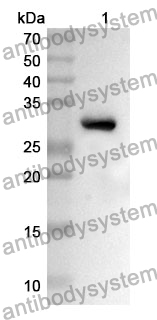Catalog No.
PHE55201
Species reactivity
Human, Mouse, Rat
Host species
Rabbit
Isotype
IgG
Clonality
Polyclonal
Immunogen
E. coli - derived recombinant Human LIMS1 (Ala68-Cys303).
Tested applications
ELISA: 1:4000-1:8000, IHC: 1:50-1:100, WB: 1:1000-1:4000
Target
PINCH,Renal carcinoma antigen NY-REN-48,PINCH1,LIM and senescent cell antigen-like-containing domain protein 1,LIMS1,PINCH-1,Particularly interesting new Cys-His protein 1
Purification
Purified by antigen affinity column.
Accession
P48059
Applications
ELISA, IHC, WB
Form
Liquid
Storage buffer
0.01M PBS, pH 7.4, 50% Glycerol, 0.05% Proclin 300.
Stability and Storage
Use a manual defrost freezer and avoid repeated freeze thaw cycles. Store at 2 to 8°C for frequent use. Store at -20 to -80°C for twelve months from the date of receipt.
Genomic collision at the LIMS-1 locus increases risk of cellular mediated allograft rejection in heart transplanted recipients., PMID:39642779
Coexistence of systemic sclerosis and cryopyrin-associated periodic syndrome., PMID:38940218
Circulating Autoantibody Profiling Identifies LIMS1 as a Potential Target for Pathogenic Autoimmunity in pathologic Myopia., PMID:38729610
LIMS1 risk genotype and T cell-mediated rejection in kidney transplant recipients., PMID:33909908
Genetic background and transplantation outcomes: insights from genome-wide association studies., PMID:31815792
Genomic Mismatch at LIMS1 Locus and Kidney Allograft Rejection., PMID:31091373
ILKAP, ILK and PINCH1 control cell survival of p53-wildtype glioblastoma cells after irradiation., PMID:26460618
Targeting of the EGFR/β1 integrin connecting proteins PINCH1 and Nck2 radiosensitizes three-dimensional SCC cell cultures., PMID:26004008
A protocol for exosome isolation and characterization: evaluation of ultracentrifugation, density-gradient separation, and immunoaffinity capture methods., PMID:25820723
Galectin 9 and PINCH, novel immunotherapy targets of renal cell carcinoma: a rationale to find potential tumour antigens and the resulting cytotoxic T lymphocytes induced by the derived peptides., PMID:24895689
Caveolin-1 and integrin β1 regulate embryonic stem cell proliferation via p38 MAPK and FAK in high glucose., PMID:21506116
Neuronal PINCH is regulated by TNF-α and is required for neurite extension., PMID:20689998
Structural basis of focal adhesion localization of LIM-only adaptor PINCH by integrin-linked kinase., PMID:19117955
Novel expression of PINCH in the central nervous system and its potential as a biomarker for human immunodeficiency virus-associated neurodegeneration., PMID:18459134
Signalling via integrins: implications for cell survival and anticancer strategies., PMID:17084981
PINCH1 regulates cell-matrix and cell-cell adhesions, cell polarity and cell survival during the peri-implantation stage., PMID:15976450
Stromal staining for PINCH is an independent prognostic indicator in colorectal cancer., PMID:15720806
Assembly of the PINCH-ILK-CH-ILKBP complex precedes and is essential for localization of each component to cell-matrix adhesion sites., PMID:12432066
The signaling adapter protein PINCH is up-regulated in the stroma of common cancers, notably at invasive edges., PMID:12216108
Characterization of PINCH-2, a new focal adhesion protein that regulates the PINCH-1-ILK interaction, cell spreading, and migration., PMID:12167643
A new focal adhesion protein that interacts with integrin-linked kinase and regulates cell adhesion and spreading., PMID:11331308
Telomeric protein Pin2/TRF1 induces mitotic entry and apoptosis in cells with short telomeres and is down-regulated in human breast tumors., PMID:11313893
Nck-2, a novel Src homology2/3-containing adaptor protein that interacts with the LIM-only protein PINCH and components of growth factor receptor kinase-signaling pathways., PMID:9843575

